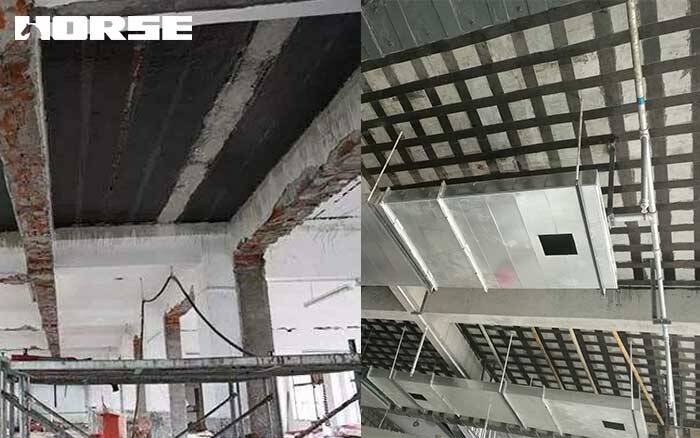Solutions
Horse Construction offers full range of structural strengthening materials with technical supports, documentation supports, products supports, project supports.
Four differences between carbon fiber reinforced masonry structure and concrete structure. The substrate is different, the bonding interface is different, the material surface defects are different, and the construction method is different.
"Four Differences", Interpretation of Carbon Fiber Reinforced Masonry Structure and Concrete Structure

The base material is different:
When the concrete structure is pasted with concrete, the base material is concrete. Concrete is an engineering composite material in which aggregates are cemented together by cementitious materials, and concrete can be regarded as a uniform and continuous material with good integrity.
When the carbon fiber is pasted to the masonry structure, the base material is composed of brick and mortar. Because the masonry building is made of single bricks and mortar, the saturation of the mortar cannot be effectively controlled, and the integrity and uniformity of the mortar are poor.
The paste interface is different:
The surface strength of the concrete structure is high. When the concrete members are reinforced with carbon fiber cloth, the concrete surface strength level should not be less than C15, and the positive tensile bonding strength of the concrete surface should not be less than 1.5MPa.
However, the masonry structure is made up of a large number of bricks and mortar. The structure has a large number of gray joints. The fullness of the mortar between the gray joints is inconsistent, and the strength of different blocks is also very different. It is impossible to uniformly assess the surface strength. The surface strength of blocks and mortar can only be determined separately. In general, the surface strength of masonry structures is not as good as the surface strength of concrete structures.
The surface defects of the substrate are different:
The surface of the concrete structure and the masonry structure need to be treated before being reinforced with carbon fiber cloth, because different materials have different defects on the surface.
Because concrete is a porous building material, during its construction process, defects such as honeycomb, pitted surface, holes, exposed bars, corrosion and cracks will appear on the concrete surface according to the construction process and other factors. Epoxy repair mortar must be used to repair carbon fiber cloth during construction before it can be repaired.
The defects on the surface of the masonry, due to the large number of gray joints in the masonry structure, due to the lack of mortar between the gray joints, the horizontal and vertical gray joints are significantly lower than the surface of the block to form a groove. When the masonry is carried out, the block has defects, the scaffold is not filled in time, leaving holes in the masonry structure, and due to factors such as the masonry level and the irregular size of the block, the flatness of the wall is poor.
The construction method is different:
When attaching carbon fiber cloth to the concrete structure, it is necessary to polish the reinforced components to reveal new concrete, remove the loose concrete, clean the surface and passivate the positive corners of the concrete components, and repair the defective areas. Then configure the impregnated glue to paste the carbon fiber cloth.
For the masonry structure, when the masonry structure is reinforced with carbon fiber, it is necessary to repair the surface defects of the masonry structure. Then, a layer of cement mortar should be smoothed on the wall and column surface. The layer thickness should not be less than 15mm and flat, and the strength of cement mortar should not be less than M10. After the smoothing layer is bent and cured, the construction is carried out according to the method of sticking carbon fiber cloth to the concrete structure.
You can find anything here you are in need of, have a trust trying on these products, you will find the big difference after that.

High strength, unidirectional carbon fiber wrap pre-saturated to form a carbon fiber reinforced polymer (CFRP) wrap used to strengthen structural concrete elements.

High strength, unidirectional carbon fiber fabric pre-saturated to form a carbon fiber reinforced polymer (CFRP) fabric used to strengthen structural concrete elements.

High strength, unidirectional carbon fiber sheet pre-saturated to form a carbon fiber reinforced polymer (CFRP) sheet used to strengthen structural concrete elements.